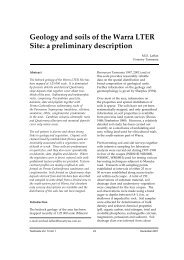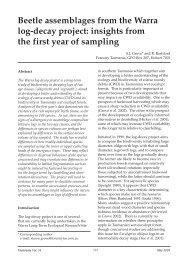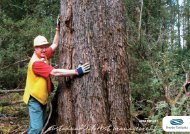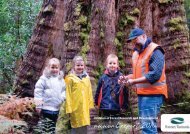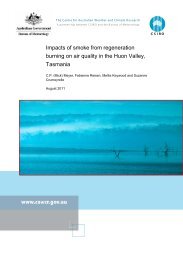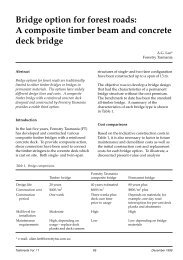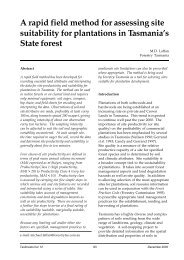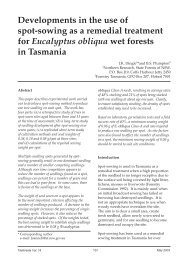The natural distribution of Eucalyptus species in Tasmania - Forestry ...
The natural distribution of Eucalyptus species in Tasmania - Forestry ...
The natural distribution of Eucalyptus species in Tasmania - Forestry ...
Create successful ePaper yourself
Turn your PDF publications into a flip-book with our unique Google optimized e-Paper software.
obvious error and unverified observations<br />
accounts for approximately 14% <strong>of</strong> the <strong>in</strong>itial<br />
16 523 observations from the condensed<br />
set <strong>of</strong> data, leav<strong>in</strong>g 14 185 <strong>in</strong>dependent<br />
identifications available for mapp<strong>in</strong>g. <strong>The</strong><br />
verified data are derived from 441 different<br />
sources and the unverified data derive from<br />
89 sources. Together, the data comprise 455<br />
dist<strong>in</strong>ct sources.<br />
Altitude occurrences and flower<strong>in</strong>g time<br />
Altitude occurrences <strong>in</strong> 100 m classes and<br />
monthly flower<strong>in</strong>g <strong>in</strong>cidence for each <strong>species</strong><br />
accompany the <strong>distribution</strong> maps. <strong>The</strong><br />
altitude data were collated with <strong>distribution</strong><br />
records. Obvious errors <strong>in</strong> the altitude records<br />
were screened by consider<strong>in</strong>g outliers <strong>in</strong> the<br />
context <strong>of</strong> the predom<strong>in</strong>ant habitat for each<br />
<strong>species</strong> and the upper and lower limits <strong>of</strong> the<br />
particular response curve. Sampl<strong>in</strong>g bias<br />
among the altitude records for each <strong>species</strong><br />
was reduced by comb<strong>in</strong><strong>in</strong>g, <strong>in</strong>to a s<strong>in</strong>gle<br />
observation, replicates from the same grid cell<br />
which differed by less than 10 m. This left<br />
20 169 records for def<strong>in</strong><strong>in</strong>g the response curves.<br />
<strong>The</strong> flower<strong>in</strong>g-time records were separately<br />
collated from EUCALIST (Chippendale and<br />
Wolf 1984), with additional records from the<br />
<strong>Tasmania</strong>n Herbarium (up to 1992), field notes<br />
(BMP) and published data (E. gunnii Potts<br />
and Reid 1985a, b; E. urnigera Savva et al.<br />
1988; E. cordata Potts 1989). Flower<strong>in</strong>g times<br />
are given for a 15-month period start<strong>in</strong>g from<br />
May (autumn) to produce an optimal display<br />
<strong>of</strong> the response curves for most <strong>species</strong>. In<br />
several cases, the flower<strong>in</strong>g <strong>in</strong>formation will<br />
be biased by extensive records from specific<br />
studies, <strong>in</strong>volv<strong>in</strong>g specific years or specific<br />
localities or, conversely, by <strong>in</strong>adequate data.<br />
Response curves for flower<strong>in</strong>g times are<br />
def<strong>in</strong>ed by a mov<strong>in</strong>g average (summed<br />
weights <strong>of</strong> 0.5 to the observation and 0.25 to<br />
each adjacent record), where each observation<br />
represents the middle <strong>of</strong> the respective<br />
month. Absence data were not available for<br />
either flower<strong>in</strong>g times or altitude responses.<br />
Thus, the documented responses (see relevant<br />
Figures on pp. 49–121) are conditional<br />
probabilities which reflect the <strong>distribution</strong><br />
<strong>of</strong> occurrences <strong>in</strong> the specified classes.<br />
Distribution types and conservation status<br />
<strong>The</strong> collated data were used to explore<br />
some attributes <strong>of</strong> <strong>species</strong>' <strong>distribution</strong>s (see<br />
Rab<strong>in</strong>owitz 1981). <strong>The</strong> geographic range <strong>of</strong><br />
each <strong>species</strong> with<strong>in</strong> <strong>Tasmania</strong> was estimated<br />
by connect<strong>in</strong>g occupied grid cells from the<br />
outer marg<strong>in</strong>al extremes <strong>of</strong> a core <strong>distribution</strong>,<br />
or from the coast, to outliers by straight l<strong>in</strong>es<br />
and <strong>in</strong>terpolat<strong>in</strong>g the number <strong>of</strong> cells with<strong>in</strong><br />
the result<strong>in</strong>g envelope (e.g. see 'extent' <strong>in</strong><br />
Gaston 1996). <strong>The</strong> aggregation <strong>of</strong> <strong>species</strong><br />
occurrences with<strong>in</strong> their range was estimated<br />
as a percentage <strong>of</strong> the occupied grid cells and<br />
the geographic range. <strong>The</strong> cont<strong>in</strong>uous<br />
variation <strong>in</strong> the <strong>distribution</strong> <strong>of</strong> the <strong>Tasmania</strong>n<br />
eucalypts is categorised <strong>in</strong>to n<strong>in</strong>e types based<br />
on the geographic range and aggregation <strong>of</strong><br />
occurrences for each <strong>species</strong>.<br />
Distribution maps, habitat descriptions and<br />
community classifications<br />
Distribution, altitude pr<strong>of</strong>iles and flower<strong>in</strong>g<br />
times for the 29 eucalypt <strong>species</strong>, <strong>in</strong><br />
alphabetical order, are given <strong>in</strong> the follow<strong>in</strong>g<br />
atlas <strong>of</strong> maps and figures. <strong>The</strong> presence <strong>of</strong><br />
a <strong>species</strong> <strong>in</strong> a grid cell is represented by a<br />
dot, the size <strong>of</strong> which reflects the number <strong>of</strong><br />
separate sources record<strong>in</strong>g a presence (Legend,<br />
p. 47). <strong>The</strong> annotated text summarises<br />
<strong>distribution</strong>, taxonomic aff<strong>in</strong>ities and ecology<br />
for each <strong>species</strong>. Specific occurrences and<br />
outliers <strong>of</strong> particular note are discussed, <strong>of</strong>ten<br />
<strong>in</strong> the context <strong>of</strong> cl<strong>in</strong>al <strong>in</strong>tergradation and<br />
hybridisation. Taxonomic notes were derived<br />
from Boland et al. (1984), Chippendale (1988)<br />
and Curtis and Morris (1975), as well as from<br />
specific studies referenced <strong>in</strong> each case.<br />
Similarly, broad habitat and community<br />
descriptions were <strong>in</strong>tegrated with assistance<br />
from the floristic classifications <strong>of</strong> dry<br />
sclerophyll forest (Duncan and Brown 1985),<br />
grassy woodlands (Kirkpatrick et al. 1988a),<br />
and wet eucalypt forest (Kirkpatrick et al.<br />
1988b), and the habitat descriptions given<br />
<strong>in</strong> Davidson et al. (1981). To avoid excessive<br />
repetition, these sources are generally not<br />
Tasforests Vol. 8 45<br />
December 1996




